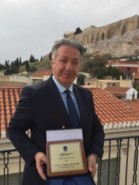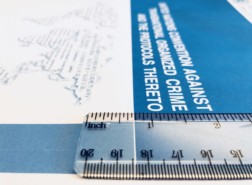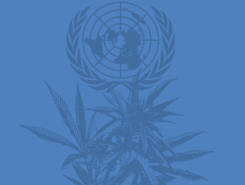Posted on 01 May 2014
As Director of Research at the United Nations Office on Drugs and Crime (UNODC) Angela Me has an enviable birds-eye view of the complex matrix that comprises transnational organized crime – or at least a sizeable chunk of it.
Me is in charge of several of UNODC’s seminal publications such as the World Drug Report, the Global Report on Trafficking in Persons, the Global Study on Homicide and the annual Afghanistan Opium Survey, publications she describes as “the global reference point of information in the areas of drugs and crime”.
This feisty, self-confessed “numbers person”, is in charge of global, regional and national research initiatives on drugs and crime — drug markets, demand, supply and trafficking; and where crime is concerned, violent, conventional and transnational organized crime, as well as trafficking of people and corruption. As such, Me certainly has her finger on the pulse of current trends in transnational organized crime. She shared some of her insights and observations with the Global Initiative.
Me’s love of statistics and numbers led her to the UN 18 years ago, and eventually to UNODC, where she has been for the past six. Armed with a Phd in statistics from the University of Padua, Italy, she worked for several years in the UN Statistics Division and the UN Commission for Europe of the UN before joining UNODC.
Me has authored and overseen a wide range of publications – analytical reports, international statistical standards, discussion papers – on population, gender, disability, migration, as well as drugs and crime. She has also served on various advisory committees, including the Scientific Committee of the European Agency for Fundamental Rights.
It’s an area Me says she “loves” working in, because “doing research on something that is so difficult, is very stimulating and challenging.” As a researcher, it is all about methodology. “We always have to think about new ways of doing research. It’s about pushing your thinking of what to do and how to do it,” she says. Although there is plenty of research out there, UNODC has a unique global overview and access to information, says Me, “that allows us to answer very key questions that everyone – from the person in the street to the president – is interested in.”
What challenges her specifically is the “transnational approach”, where “we are not just looking at the sum of all countries but at something else that has value in itself. I love the challenge of looking at the transnational dimension and having to find new ways of doing research.” Working with numbers, says Me, is what she enjoys. But what she enjoys even more is “applying this to real and relevant phenomena. The challenge is to translate numbers into knowledge, to bring the number perspective into knowledge-based research.”
Me lives in Vienna with her husband and two children. “We’re a number-oriented family,” she laughs. She applauds her husband, a physicist who is currently researching innovative radiation therapy to cure cancer, because he has always encouraged her to pursue her career. This has taken them from New York to Geneva to Vienna, requiring him to start over each time. The family returns often to their home country of Italy. The food, says Me, is what she misses most about home. She and her husband share a love of hiking. “For me, that’s where I find my peace,” she says. The children, however, would rather stay behind …
1. What are some significant trends in drug trafficking that have emerged in recent years?
One emerging trend is the new routes that opium from Afghanistan is taking. Traditionally it reached Europe via the Balkan Route but now we are seeing it pass through parts of Pakistan and Iran down to East and West Africa before finding its way back into lucrative markets in Europe. West Africa has long been a conduit for cocaine but the influx of heroin and opium is a new phenomenon. This is of great concern given the vulnerability of many states in these regions.
A second recent trend is that Africa is becoming a source – not just a conduit – for drugs, namely methamphetamine. Some meth labs have been seized in Ghana, Nigeria and other parts of West Africa. The drug is going to South Africa and Asia, where the market is really lucrative. While we don’t have comprehensive data of drug use in Africa, we do have anecdotal evidence of increased drug usage in both West and East Africa. We are conducting a drug use survey in Nigeria and – given that it is such a big country – this will give us a good indication of what is happening more broadly in the region.
A third trend is the proliferation of diverse narcotic substances that are not under international control. Many of these New Psychoactive Substances (NPS) are extremely harmful. Some examples are synthetic cannaboids sold as ‘spice’ or “bath salts”; ketamine in Asia; and mephedrone in the UK, which has been linked to many deaths. Because these are not controlled substances they are not technically illegal and can cross into multiple countries without restrictions. People don’t perceive them as harmful but they are in fact just as harmful as traditional drugs.
A fourth trend is the legalization of marijuana in some states in the United States and Uruguay. From a research perspective the impact of these new laws on health will be interesting. We have to bear in mind that marijuana is not just associated with recreational use, but with problematic use too. We will only be able to assess the impact five years from now. It will be interesting to see also what impact this legislation has on other countries and other US states.
2. What other types of organized crime are on the increase or decrease? Can you explain why?
Unlike with drugs, where we have a developed information system on the global picture because we can pick up what we see on the surface – from seizure and consumption patterns for example – to understand what’s happening below, it’s harder to understand the levels of other types of transnational organized crime.
What we do see though is that organized crime is moving into more loosely regulated areas than drugs, which are now under stricter control. Organized crime is constantly taking advantages of loopholes in legislation or weak links to take resources from poor countries illegally to rich countries, where the benefits can be large. We are seeing more sophistication, different modus operandi and the constant exploitation of new areas, not necessarily typical ones like drugs and firearms. There is more and more transnational criminal activity relating to the exploitation of natural resources in both Asia and Africa – illegal logging in Asia and mining and ivory trade in Africa, for example. Another emerging global crime is waste management. Waste produced in rich countries is being illegally diverted to poorer countries in Africa and Asia by organized crime groups, which is taking advantage of the complete lack of regulation by offering waste management solutions that are cheaper but that impact negatively on the environment. This is not being seen as the threat that it should be.
What we’ve also seen more recently is that the more regulations society puts in place to regulate globalization, the more organized crime exploits the loopholes and finds other ways to operate. It’s a fertile environment to benefit from.
3. How is the research paradigm changing? Are researchers asking the same – or different – questions in their attempt to get to the bottom of what drives transnational organized crime?
As we’ve seen with drugs and the emergence of NSPs, the terrain is always changing, and this poses new challenges. For example, we have traditionally collected data on drug use by asking people questions like, ‘how often do you use cocaine?’. Now, most people don’t know exactly what they’re using and we need to think about innovative ways to collect information. We have to constantly reexamine our research methods and develop instruments that allow us to capture the qualitative dimension. Another challenge is that all the areas we research at UNODC are politically sensitive and often motivated by ideology. How do we ensure that our research leaves ideology and politics aside? We have to concentrate on collecting objective evidence. Also we have to continually broaden our scope to include new issues we have not studied, like waste for example.
4. There appears to be increasing evidence on the overlap between terrorism and transnational organized crime in conflict-ridden states like Somalia, Libya and Mali. What is your view?
We are increasingly being asked to look into this link although many of our member states are opposed. In the past, many countries didn’t want to link the agenda of terrorism with organized crime; others were simply not interested. Now, however, this is changing. In the past couple of years we have had more member states asking us to look into this, although some countries still don’t want to publicize or focus on it. But given the emerging trends in Africa we will probably be pushed to look into it further. It’s a political issue, though. How you collect evidence on trends such as these that does more than simply reflect perceptions formed from anecdotal information?
5. Can you comment on the reported split in the UN on the war on drugs? Where does UNODC stand?
I would not say that there is a split in the UN on drug policy. There is within the UN an open (and interesting) exchange of ideas and there may be different angles or particular interests that each agency takes in line with its mandate, but overall the UN has one line: UN response to the drug problem should be guided by the drug conventions with a recognition that the conventions should be implemented within the framework of the Rule of Law and with a balanced approach and health protection at the center of the response.
6. What is your comment on the argument of many organizations that countries should be focusing more on the demand side, and perhaps spending more money on harm reduction, than on the supply size, and seizing contraband, which they argue is not succeeding in stemming the flow of drugs.
I fully support the argument. UNODC is one of the organizations that promotes a renewed health-centric approach. Even in research we have gradually expanded our attention to drug use and its health consequences. In addition to the regular analysis of drug use, the World Drug Report has expanded over the last few years the analysis of issues related to drug use and in particular, injecting drug use and HIV. UNODC has initiated joint research with UNAIDS, WHO and the World Bank and the forthcoming 2014 World Drug Report will present the first joint estimates on injecting drug use and HIV and service provision.
7. What do you think confounds the researchers the most?
Trying to research something that you never see is very challenging. Also, it’s a field that is very opinionated. People like research, but when you bring it to the table is is often not accepted as real evidence because whoever uses the results has a political agenda. It’s hard to get pure evidence and it’s even harder to get people who use the data to appreciate the purity of evidence when you do get it.
8. What is the benefit of the Global Initiative against Transnational Organized Crime?
Every year we see conventions on transnational organized crime. Countries always recognize that the problem cannot be solved unless we all act together and have the same vision for solving it. Crime doesn’t have borders so the actions against crime cannot have them either. It is very important that the drug problem is addressed with international co-operation because no country – regardless of how powerful – can address it alone. The GI brings this global perspective. We can only fight these transnational networks if we have international networks as well. I see the work of the GI as complementing the institutional process of the UN. In the UN, every time we move, we take a big step but these steps come slowly. The informality of the GI allows initiatives to be taken faster and to build on what the UN is doing.



